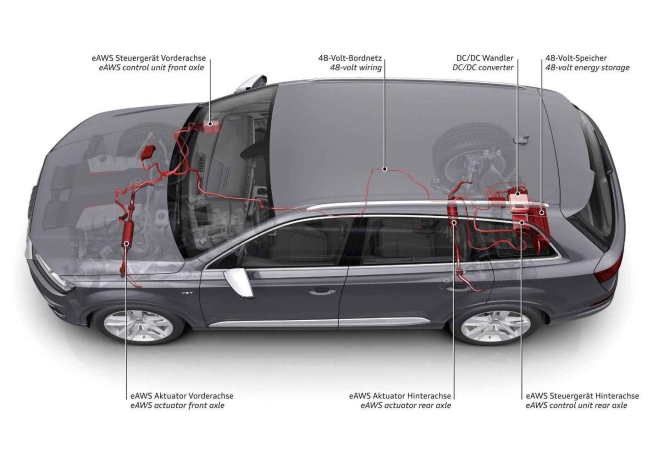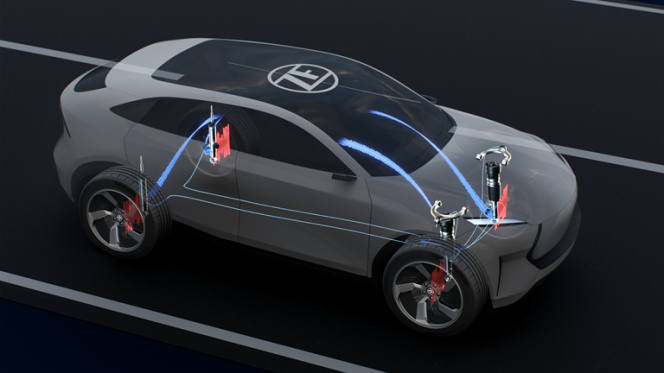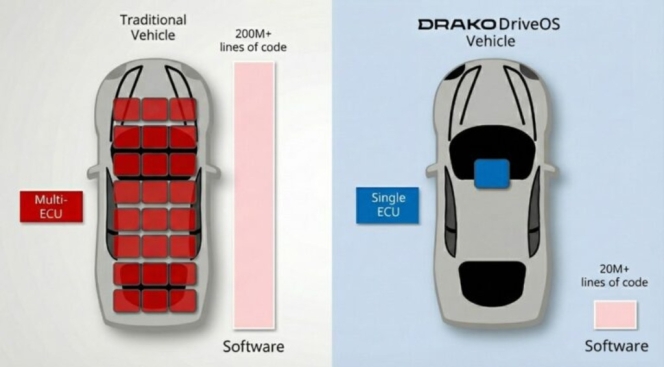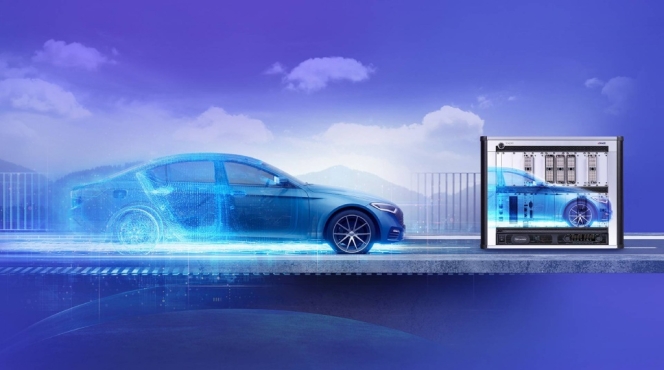Audi's eAWS Turns SUVs Into Quick-Change Artists
- By MT Bureau
- August 29, 2020

How do you provide a large SUV with sporty road-holding properties and minimal body roll without impairing ride comfort? Audi has resolved this by implementing electromechanical roll stabilization (eAWS). Assisted by the 48-volt onboard electrical system and powerful actuators, the stabilizers on the front and rear axle can be actively controlled according to the driving situation. As a result, the models retain their high level of ride comfort in straight-line driving. By contrast, in cornering and load alteration situations, they impress with enhanced lateral dynamics combined with minimal body roll. The technical advantages of Audi’s electromechanical solution: it is energy-efficient, operates in near-real-time and is virtually maintenance-free due to the absence of hydraulic elements.

What challenges do large SUV models pose to chassis engineers?
Customers of larger SUVs are thrilled by their many practical elements – from ample space in the cabin to cutting-edge chassis technologies to powerful engines and advanced control and assistance systems. Plus, an SUV can deliver superb performance off paved roads. Due to their design, these vehicles feature a higher curb weight and a higher center of gravity. This means that the body of an SUV leans more toward the outside in cornering than it does on models with a lower center of gravity.
What technology counteracts body roll and body movements?
In cornering, the body leans toward the outside due to the centrifugal forces, in other words, the wheel on the outside of the corner goes into jounce travel while the one on the inside of the corner goes into rebound – the vehicle rolls around its longitudinal axis. Torsionally flexible anti-roll bars between the left- and the right-hand side of the axle are proven means of compensating for this effect. They help reduce the body’s tendency to roll by applying reverse torsion torque to the suspension on the outside and inside of the corner, thus counteracting the body’s tendency to roll. This passive suspension component has the same effect in both cornering and straight-line driving. However, an effect that is desirable in cornering may impair ride comfort in straight-line driving on roads with bumps or potholes on one side of the surface. While passive solutions can reach their limits here, Audi has resolved this by means of electromechanical roll stabilization. Using sensors to capture and detect the situation, the system is designed to intervene with pinpoint precision only when less body roll is desired. Thus, the spring rate of the stabilizers on uneven and straight roads is lowered to a basic level and the spring and damper forces act by and large independently on the left- and right-hand wheels.
How does electromechanical roll stabilization work?
A conventional stabilizer operates passively. In other words, it just balances the suspension movements on both sides by means of mechanical coupling. By contrast, electromechanical roll stabilization can be specifically controlled. The system consists of two stabilizer halves per axle, with an electric motor operating between them on both the front and rear axle. It can rotate the stabilizer halves in opposite direction of each other and thus generate torque that counteracts body roll torque – individually for each wheel. As a result, it reduces the body roll angles and actively supports them against the physical effects of the driving situation. The system receives its commands via control units on the front and rear axle, which are part of the Electronic Chassis Platform (ECP). The ECP is the central brain of the chassis. Within milliseconds, it matches a variety of parameters such as speed, ride height, roll and pitch movements of the car, the friction coefficient of the road surface, the current driving condition such as under- or over-steer, plus the data of the chassis systems involved. From this input, the system calculates the ideal responses for the integrated components and adjusts them quickly and precisely to each other. The required electrical energy is supplied to the eAWS by a powerful 48-volt onboard electrical system. Within milliseconds, the system calculates suitable actuation values for the stabilizers. The electric motors deliver their power output via three-stage planetary gearboxes, with torque levels of up to 1,200 Nm being generated at the stabilizers.
What is “Vorsprung durch Technik” in the case of an electromechanical solution?
The 48-volt system enables an immediate system response even at low speeds. Latency between the sensors detecting body roll and the response by the electric motors is just a few milliseconds. Unlike hydraulic solutions, the eco-friendly electromechanical system does not require oil circuits and is maintenance-free. It is even able to recuperate energy by capturing suspension impulses on its electric motor, converts them into electrical energy and stores it in the lithium-ion battery of the onboard electrical system. The electromechanical solution uses energy more efficiently as well. In contrast to hydraulic circuits, it does not have to store and provide pressure.
How does the driver benefit from the system?
The system helps reduce the body’s tendency to roll, provides a sportier and more confident handling impression and emphasizes the versatile character of the large SUV models. It can actively distribute roll torque to the front and rear wheels and influence the car’s intrinsic steering characteristics such as the tendency to under- or oversteer. The Audi drive select driving dynamics system offers various setup options for this. Electromechanically active roll stabilization imparts to the driver a dynamic and precise feel in a variety of situations and enables enhanced handling characteristics. It is one of various systems that perfect the dynamism of the top-end models of the Q range. The Audi Q7, SQ7, SQ8 and RS Q8 models with their controllable stabilizers respond to the driving situation precisely as expected by the driver. On uneven road surfaces, the body movements are reduced while ride comfort increases. In sporty driving and at high cornering speeds, the car feels more stable and at ease. It pushes itself into a bend in the road. Audi has deliberately selected a setup that does not completely neutralize the roll angle but continues to impart an authentic feel of the driving dynamics situation.
How is the system on the racetrack and the real world?
Impressive proof of the influence of the controllable stabilizers was provided by race and test driver Frank Stippler in the fall of 2019. As part of the development work for the Audi RS Q8 the professional race driver, who in 2019 won the 24-hour race at the Nürburgring for the second time with Audi, set a new lap record for production SUVs. He managed to drive the 20.832-kilometer distance of the race track in the Eifel region in just 7:42 minutes. Forty percent of global Audi customers who have ordered a large Audi SUV model have chosen the option of electromechanical active roll stabilization. (MT)
ZF To Present Software Active Noise Reduction For Vehicle Chassis At CES
- By MT Bureau
- December 17, 2025

German tier 1 supplier ZF is presenting a new ‘Active Noise Reduction’ software function for vehicle chassis at the Consumer Electronics Show (CES) 2026. The purely software-based function reduces in-vehicle tyre noise transmitted through chassis components without requiring additional hardware. The company plans to expand the use of the function to other ZF chassis actuators in the future.
The solution uses ZF’s Smart Chassis Sensor with an integrated acceleration sensor to measure vibrations from the tyres. A developed algorithm recognises the characteristic noise patterns of tyre cavity noise around 200 hertz.
The software generates a counter-signal via ZF’s cubiX software through the valves of semi-active dampers (CDC). The function uses micro-movements of the damper to specifically reduce noise interference without impairing the damper function.
The technology achieves noise reductions of more than 3 dB, with future potential for up to 10 dB. This software-based noise reduction is achieved without additional installation costs or space requirements. Active Noise Reduction can be adapted to different vehicle types via software, opening a market for lower-priced vehicles.
Dr. Peter Holdmann, Member of the ZF Board of Management and Head of Division Chassis Solutions, said, “Active Noise Reduction is an excellent example of how we use smart algorithms to make ZF components even more efficient. This gives our semi-active CDC dampers a clear unique selling point in the market and sets new standards in comfort – without the need for any additional noise dampening hardware.”
Series production is scheduled to start in 2028. In the future, the function may be used in other ZF actuators, such as for active reduction of brake squeal.
Holdmann added, “Thanks to our system expertise, we are able to offer our mechatronic actuators as true innovation drivers with the help of smart algorithms and we will extend our software-based control approach to other ZF actuators in the future. The goal for us is clear: mechatronic actuators that are capable of efficiently reducing both their own and external noise with the help of software.”
The new function fits into ZF’s Chassis 2.0 product strategy, which uses intelligent and networkable actuators to enable new chassis functions via software.
Holdmann noted: “With our Chassis 2.0, we are laying the foundation for the software-defined vehicle.”
Drako Tech Unveils DriveOS With Single-ECUArchitecture
- By MT Bureau
- December 17, 2025

California-based Drako Tech has announced DriveOS with HyperSafety, an automotive operating system designed for single-Electronic Control Unit (ECU) operation. The platform consolidates vehicle subsystems, including control systems, ADAS and digital cockpit, into one unit to reduce costs and enable over-the-air (OTA) updates.
Launched in 2015 and utilised in Drako GTE and Drako Dragon vehicles, DriveOS supports internal combustion, electric and hybrid propulsion systems.
The HyperSafety system provides real-time performance via a single-ECU architecture. According to Drako Tech, the networking backbone facilitates communication four times faster than multi-ECU Time-Sensitive Networking (TSN) automotive Ethernet.
The architecture employs hardware isolation and redundancy to maintain operation during component failures. By using a reduced code footprint and hardware partitioning, the platform aims to limit attack surfaces for cyber security and streamline validation processes.
Industry Integration
Drako Tech provides development environments that run natively on DriveOS:
- Control Systems: Allows engineers to build vehicle controls from Simulink models.
- Digital Cockpit: A system for instrument clusters, navigation and multimedia.
- ADAS: A software foundation for driver assistance with low-latency control.
The platform addresses the complexity of multi-ECU architectures, which typically require separate units for functions such as seats, doors and thermal management. Drako Tech uses a separation kernel to run safety-critical systems alongside non-critical systems, such as infotainment, on the same ECU.
DriveOS introduces hard real-time capabilities to Linux without requiring kernel changes. This allows developers to use Linux libraries and tools for safety-critical systems.
Key features include:
- Performance: 108-microsecond end-to-end performance compared to 514 microseconds for TSN Ethernet.
- Consolidation: The ability to move functions onto a single PC architecture to reduce hardware mass and complexity.
- Redundancy: Hardware-backed isolation ensures faults in one subsystem do not affect driving functions.
- Cloud Integration: Real-time fleet management and diagnostics without creating access paths to control systems.
Dean Drako, CEO, Drako Tech, said, “Nearly half of the cost of new vehicles is tied up in software and electronics. Drako Tech now offers all OEMs worldwide – regardless of size or influence – a definitive leap in their ability to deliver exceptionally safe, connected, AI-enhanced vehicles, with massive cost advantages. We are the first to achieve the ultimate goal – a single-ECU, hard real-time operating system and unified electronics architecture with mixed criticality – while providing OEMs a flexible deployment path.”
dSPACE To Present AI-Driven Test Solutions For SDV At CES 2026
- By MT Bureau
- December 17, 2025

German technology company dSPACE is set to showcase end-to-end test solutions at CES 2026 to assist vehicle manufacturers with the development of software-defined vehicles (SDV).
The company will present a validation portfolio featuring AI-supported software-in-the-loop (SIL) and hardware-in-the-loop (HIL) solutions.
It is exploring how generative and agentic AI technologies can support SIL testing and enable CI/CD pipelines for validation. An exhibit will demonstrate a Visual Studio Code and GitHub Copilot solution for the generation of virtual ECUs for SIL tests.
To meet the requirements of short-cycle development, dSPACE is demonstrating a CI/CT concept presenting a cloud-native validation approach. This includes a GitLab pipeline integrated with VEOS, the dSPACE SIL test software, and SCALEXIO, the HIL test platform.
dSPACE is also presenting a HIL Farm Management Demo designed to increase test efficiency. This displays the availability and utilisation of HIL systems and potential errors to reduce system downtimes and improve the use of test resources.
The technology company will use its test solutions for battery charging and battery management systems to demonstrate end-to-end SIL/HIL validation. Efficiency is increased by reusing test cases, simulation models, bus configurations and user interfaces across both methods. This allows for the demonstration of functions, including conformance tests, with the same layouts and cases.
The company is introducing DARTS ARROW, a radar solution for functional testing of sensors. Developed for end-of-line tests and periodic technical inspections, it validates safety systems such as emergency braking and lane departure warnings by simulating traffic scenarios to detect sensor errors.
For security, dSPACE will present HydraVision, a cybersecurity test framework. Using test case templates, it allows for the integration of cybersecurity tests into the development process to identify and mitigate weak points.
Additionally, the new SCALEXIO Essential system expands the SCALEXIO real-time platform. It is designed for the validation of edge ECUs for mechatronic applications in the automotive, agricultural, and construction machinery sectors. The system includes a software package and is intended as a cost-efficient entry point for HIL testing.
Greaves Cotton Appoints Santosh Singh As Chief Strategy And AI Officer
- By MT Bureau
- December 16, 2025

Greaves Cotton has appointed Santosh Singh as Chief Strategy and AI Officer. He will be based in Mumbai and will lead strategy, transformation, AI-led enterprise capability building and business excellence for the Greaves Cotton Group.
Singh comes with over two decades of experience in strategy, business excellence, innovation, and AI-led enterprise transformation. He joins Greaves Cotton from Tata Technologies (TTL), where he served as Global Head – Marketing and Business Excellence. During his tenure there, he co-led the enterprise GenAI roadmap and developed use cases focused on customer engagement and productivity.
His primary mandate is to drive the Greaves.NEXT strategy, the company’s roadmap for growth across the energy, mobility and industrial solutions sectors.
In his new role, Singh will focus on accelerating growth for Greaves Technologies (GTL), developing an enterprise-wide AI roadmap, and establishing partnerships with hyperscalers and AI labs.
Parag Satpute, Managing Director & Group CEO, Greaves Cotton, said, “We are pleased to welcome Santosh to the leadership team. His extensive expertise in strategy, digital transformation, and AI will play a significant role in shaping Greaves’ next phase of growth. His global experience will further strengthen our innovation roadmap and support our long-term business priorities.”
Singh will also work across business units to incubate and scale growth vectors and lead business excellence initiatives.






Comments (0)
ADD COMMENT